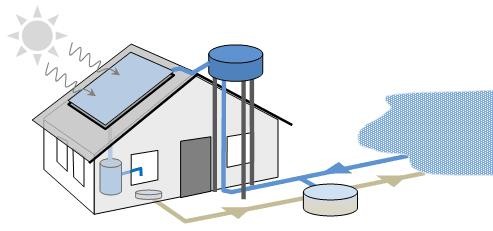Nano-structured TiON Photo-Catalytic Membranes for Water Treatment (NATIOMEM)
The NATIOMEM consortium has developed a new photocatalytic membrane for water and wastewater treatment. The coated membrane, when irradiated by sunlight, is capable of oxidizing micropollutants and inactivating microorganisms. The coated membrane could be integrated into a treatment system, for water treatment without chemical addition.

The challenge
Due to the insufficiency of available water in many regions of the world, the need for developing new water treatment technologies for both potable and non-potable water is of paramount importance.
Although traditional processes have significantly improved, novel technologies are still required concerning point-of-use systems (i.e. remote places where the service is needed), especially in areas where electricity is not accessible. In this context, nanotechnologies are likely to represent promising solutions.
The innovation
NATIOMEM has addressed such a challenge by developing a technically and economically viable depolluting device consisting of an active coated membrane. The membrane is composed of a nitrogen-doped titanium dioxide TiON coating on a porous substrate. The coating is able to generate photo catalysis by irradiation in the visible range, thereby leading to an oxidation process of micropollutants. This membrane should be integrated in drinking water treatment systems in rural areas where electricity is not available as well as in decentralized non-potable recycling systems. The novel photo catalytically active membrane is composed of a porous substrate with a photocatalytic coating on the surface. The treatment unit makes use of a combined process for filtrating and oxidizing pollutants: the design aims at performing a physical filtration and retention of particles, while the coating aims at oxidizing organic pollutants and at inactivating microorganisms.
Several coating techniques (including sol-gel, sputter deposition, atmospheric pressure plasma jet and filtered vacuum arc deposition) were tested on a series of substrates. The coatings were characterized with various analytical techniques such as x ray diffraction (XRD) or scanning electron microscopy (SEM).
The photo catalytic activity (PCA) of the coated membranes was tested in laboratory: the main test parameter taken into account was photo catalytic degradation of carbamazepine (CBZ) used as a model pollutant.
The best result has been achieved with a sol-gel coating on an aluminium oxide membrane.
Good progress was made within NATIOMEM on TiON doping and material science. In addition to the sol-gel coatings applied to the membranes, further coatings were developed that have potential for other applications, such as hydrogen production and low cost solar cells.
Why did it work?
Natiomem was coordinated by DHI (Danish Institute of Applied Hydraulics –Vandbygningsinstituttet, Denmark), an international research and consulting organisation, from July 2010 to June 2013. The project consortium gathered material scientists and water experts from universities and technical centers & experts, in association with specialists from the water industry. The technical outputs were field-tested at pilot scale in South Africa and Jordan. In South Africa, the targeted application was provision of potable water in rural communities, where electric power infrastructure is lacking. In Jordan, a unit to treat domestic grey water was set up, thereby addressing the Jordanian official strategy to reuse grey wastewater for non-potable purposes.
Further deployment
NATIOMEM was co-financed by the Seventh Framework Programme (FP7), a grant funding programme from the EU. Based on the results obtained at the laboratory level, three pilot plants were designed and built in South Africa and Jordan. The laboratory results project showed encouraging performance regarding the disinfection of potable water. The pilot plants however demonstrated that pre-filtration, manual cleaning and the use of additional electric power for pumping will be required, thereby increasing the cost of the treatment unit (maturity level is estimated to be 8 on the TRL scale). As a result, laboratory and pilot tests outputs were translated into updated recommendations in order to focus the development into a water treatment unit. The consortium estimates that the coated membrane presented good potential for commercialization.
